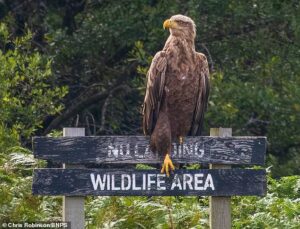
Surging waves were about to doom his terrified daughter to the frigid depths of the Atlantic Ocean after she suddenly fell overboard from the Disney Dream cruise ship on Sunday.
Disaster struck on June 29 as the vessel headed to Fort Lauderdale, Florida, during their family adventure, forcing the 37-year-old father to bravely jump about 50ft into the ocean himself to save the frantic five-year-old before she drowned.
The drama, which has entranced the world, could have proved fatal, but crew members on the liner’s small orange tender rescued the shivering pair.
The incident, a travel expert tells the Daily Mail, is a riveting example of how danger can strike mercilessly without warning – including during a relaxing holiday – and highlights how threatening some favorite vacations can be for Americans.
Indeed, the nation’s most popular tourist destinations harbor perils that can lead to sudden tragedy and loss of life, personal injury attorney Jeffrey Reiff tells the Daily Mail in an exclusive interview.
‘Even the most innocent place can be the most dangerous,’ he explains. ‘The reality is there’s glitches when we travel – or worse. Things don’t always go as planned and catastrophic accidents happen.’
His Philadelphia law firm has represented countless clients and their families who have suffered life-changing incidents while on vacation, often resulting in serious physical injuries, brain damage and sometimes fatalities.
He highlights the nation’s beloved national parks, famous for their natural wonder, which he says are among the most notable danger zones for tourists.
‘When you’re in a wild environment, animals can attack – you could get eaten alive in any of these places,’ says Reiff.

Philadelphia personal injury attorney Jeffrey Reiff
‘You have to deal with natural wildlife such as snakes, scorpions and animals that people don’t think about, as well as insect bites that can that can lead to infections.
‘When you’re on a romantic trip having a glass of champagne with the sun setting over some great scenery, the last thing you think about is something that’s going to result in a tragedy,’ he cautions.
His clients and their families have endured ‘the worst moments when the unthinkable occurred.’
And, he said, even money can’t protect you.
‘Some of the worst cases I’ve seen have happened in the most luxe resorts – assaults, food poisoning, a catastrophic failure of equipment that leads to an awful situation.
‘We expect to have some Kodak moments and make great memories – but your guard is down and you’re not thinking.’
Insurance companies use a system called micromorts to calculate the probability of death while participating in certain vacation activities. A micromort is a unit of risk that equals a one in a million chance of dying – and one micromort is roughly equivalent to a 230-mile car journey.
‘People just have to understand that when you do things out of the norm, there’s a risk,’ Reiff said. ‘When you’re on holiday, it’s supposed to be a pleasurable experience but we really still have to exercise caution.’
Here the keen outdoorsman and traveler assesses the comparative risk factors of some of the most popular getaway destinations and activities favored by Americans in search of a good time.

The Grand Canyon is the most deadly national park in the US
1. Grand Canyon – Risk Factor: HIGH
The mile-deep chasm in Arizona, carved out over millions of years by the mighty Colorado River, is ‘rife with a lot of potential dangers’ for tourists, says Reiff.
The prevalence of potential cliff falls, heat exhaustion, scorpions and snakes, for example, is exacerbated by a lack of proper medical attention in remote areas
The Grand Canyon National Park has been proclaimed the deadliest of the nation’s 63 national parks.
In 2023, a 33-year-old tourist fell 4,000 ft to his death at the fear-inducing Grand Canyon Skywalk which is mounted atop the huge land feature.
At least six people died – and 56 went missing – between 2018 and 2013, records show.
By comparison, four people each died at Yosemite, Golden Gate Park and Death Valley national parks during the same five-year period.

Despite the increase in instances of Norovirus onboard cruise ships serving American tourists, the risk factor is low, says attorney Jeffrey Reiff
2. Cruise Ships – Risk Factor: LOW
Cruise ships have had a sinking reputation in recent years when vessels became breeding grounds for the Norovirus, often referred to as the ‘cruise ship virus.’
In April, an emergency warning was issued about a new strain of the highly contagious and deadly gastrointestinal illness sweeping through cruise ships and impacting passengers.
On June 10, Netflix debuted a documentary recalling the infamous Carnival Triumph ‘poop cruise’ of 2013 when human excrement streaked down walls and passengers fought over rationed food supplies after an engine room fire left the vessel drifting powerless in the Gulf of Mexico.
Reiff warns of the chance of sex assaults by crew members, intoxicated guests, on-board infections and food diseases, polluted hot tubs and swimming pools and unpredictable weather conditions causing rough seas.
He also cautions against using ‘shoddy operators’ during on-shore excursions, such as zip-line adventures.
Despite the many risks, he still calls cruising ‘fairly safe’ considering the enormous numbers of passengers each year.

The mountainous coastline of Oahu, Hawaii, where Jurassic Park was filmed
3. Hawaii – Risk Factor: MEDIUM
Despite the enticing allure of picture perfect beaches, epic mountainous coastlines and other stunning scenery, there can be plenty of trouble in paradise, Reiff suggests.
Hazards that come with the Pacific Islands include rogue waves, rip tides, shallow reef injuries and hikers falling from trails. There are also injuries from visiting the islands’ awe-inspiring volcanoes, including dangerous toxins spewed into the air.

New Smyrna Beach was crowned the country’s most lethal beach
4. New Smyrna Beach – Risk Factor: LOW
Despite its popularity, this sweeping stretch of sand on the eastern coast of Central Florida has been declared the country’s deadliest beach, dubbed the ‘shark bite capital’ of the world.
Researchers based their findings on the number of shark attacks, surfing fatalities and destructive hurricanes in the area.
In July 2024, officials in New Smyrna recorded nearly 400 beach rescues in just a matter of days due to high rip currents and crowds.

Death Valley in the Mojave Desert
5. Death Valley – Risk Factor: LOW
Reiff revealed his wife has been ‘very paranoid’ during trips to the ominous-sounding Death Valley in the Mojave Desert in eastern California where searing temperatures regularly reach record levels.
‘Always carry provisions, plenty of water and a cell phone,’ he advises while traveling through the area.
In 2021, Blake Chaplin, 52, from Leawood, Kansas, was found dead on a Death Valley trail.
The married father-of-two from Kansas was one of two hikers who died on the Golden Canyon Trail just days apart amid scorching temperatures in the area.
A search-and-rescue team recovered the body after it was reported by an early morning hiker. Days earlier, he body of Lawrence Stanback, 60, of San Francisco, was recovered by park officials.
On Aug. 15, 2024, Death Valley hit 130 F – it may have been the hottest temperature on Earth ever recorded.

Pictured: The beach in Quintana Roo, Mexico, where a woman, originally from Los Angeles, died in crossfire last year
6. Mexico – Risk Factor: MEDIUM
According to Reiff, the situation south of the border is more dicey these days with rampant gang activity and death squads.
‘There’s more violence with gangs,’ he says. ‘You have to use common sense and be diligent about your surroundings.
‘Do your research to see if there have been have there been criminal activities in this area.’
Last year, a Los Angeles woman staying at a beach club in Tulum was shot in the head and killed when she was caught in crossfire between two drug gangs while innocently watching the sunset.
There are plenty of ways to stay safe while visiting Mexico – and each area of the vast country has a different level of risk associated with it – so doing your research before you go will help.

Police in the British Overseas Territory are deploying all resources to find the New Yorker, including drone scans and thorough reviews of CCTV footage to trace his movements on the night he disappeared (pictured: aerial photo of Turks and Caicos)
7. The Caribbean – Risk Factor: HIGH
According to Reiff, the Caribbean is another high-risk destination for American tourists in search of sun, sea and sand in the tropics.
‘Some islands are worse than others,’ he explained, ‘and if there’s conflict going on in the islands known for drugs there are potential issues. You have to be on guard and careful if you go off the beaten path.’
The attorney recalled that in the past he had been robbed, assaulted and suffered from food poisoning while there.

Missing New Yorker Brian Tarrance, pictured with his wife, vanished last month during a vacation to Turks and Caicos in the Caribbean
He said his firm has represented ‘a lot’ of sexual assault victims who stayed on the islands and were even targeted while guests at lush, high-end resorts due to a lack of thorough background checks on staff.
There are also drownings and ‘body parts sucked’ into hot tubs, he added, because hotel pool facilities are not properly maintained or supervised.
Last month, a New York City man vanished while vacationing in Turks and Caicos after mysteriously leaving his rental property in the middle of the night.
Brian Tarrence, 51, of Midtown Manhattan, was visiting Grace Bay for a getaway with his wife of one year but disappeared from their rented property three days after arriving.

Amusement and water parks are among the most dangerous tourist destinations in American, accoridng to attorney Jeffrey Reiff
8. Amusement Parks – Risk Factor: HIGH
Reiff tells the Daily Mail he’s represented many victims and their families who have been injured at amusement and water parks across America – the result of poor industry regulations, ineffective equipment maintenance and inexperienced staff.
‘They’re in business to make a profit – sometimes they take shortcuts,’ he says.
‘People go to amusement parks and they think, “Oh, we’re going to take the kids out for a nice time with some ice cream and cotton candy,” but they never realize what the dangers are.’

Lake Mead is nicknamed ‘Dead Body Soup’ by locals for the high number of deaths that occur at the Nevada hotspot
9. Lake Mead – Risk Factor: MEDIUM
Lake Mead, created by the Hoover Dam, is located on the Colorado River, primarily in the states of Nevada and Arizona, 24 miles east of Las Vegas. It has been named ‘Dead Body Soup’ by locals due to the number of bodies that have turned up in its waters over the years.
It’s a popular destination for tourists to enjoy the scenery with boats, jet-skis and water skiing. But accidents and fatalities are common and alcohol is often a factor.
‘Anyone can get on a jet-ski that’s going 40, 50, 60 miles an hour,’ says Reiff.

Bison grazing in Yellowstone National Park in Wyoming
10. Yellowstone – Risk Factor: HIGH
‘Any time you’re in a wild environment the risk is going to be higher,’ said Reiff.
This is especially the case with Yellowstone National Park in Wyoming. ‘There’s a lot that can go wrong in a park unless you’re trained,’ he says.
‘Where there’s raging waters, animals, snakes, hot sulphur pools and wildlife, people have a tendency to hike off the beaten path.
‘They forget that nightfall is coming or that there are animals out in the wild.’
The advent of cell phone cameras and selfies means that people ‘attempt to get out of their car to pose with a dangerous animal in the background that can charge.’





